Explainer
- Explainer
- Climate policy
Space mirrors, fake volcanoes: the radical plans to fix the climate
The world’s top scientists are now scoping drastic measures to halt the climate crisis, from planting a trillion trees to building giant sun shades for Earth. Would they work? Or are they out of the question?
Man-made "volcanoes" shooting sulphur into the sky. A giant space umbrella made up of tiny mirrored ships to block the sun’s light. Re-freezing the poles by pumping seawater through clouds. Covering deserts in reflective sheeting.
They sound like plots from James Bond films. But as the world teeters closer to climate catastrophe, it’s increasingly scientists, not supervillains, who are giving serious thought to these radical methods of cooling the planet.
Proposals once relegated to the fringes of science are now being tested by the likes of NASA, Cambridge and Harvard. Major scientific authorities, including the Royal Society of London and the UN's own Intergovernmental Panel on Climate Change (IPCC), say we should at least canvass our options for hacking the planet - as an insurance policy if nothing else. This year, for the first time, the US Congress approved millions of dollars in solar reflection research. At the 2020 World Economic Forum almost every head of state, including US President Donald Trump, threw their support behind a large-scale plan to plant and restore one trillion trees across the globe.
But tweaking the planet could bring its own set of headaches. Some are calling for more regulation to rein in this wild frontier of geo-engineering. Others say it's time to be brave in the face of a ticking climate clock.
So what are the ideas being considered, would they actually work and which ones are already in the pipeline to change the world as we know it?
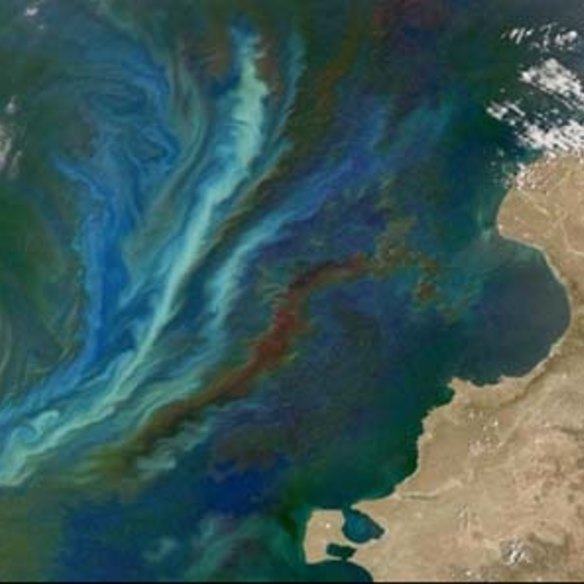
Could artificial algae blooms help stop global warming?
What is geo-engineering?
In 2012, controversial US businessman Russ George was accused of breaking two UN conventions when he dumped 100 tonnes of iron filings into the Pacific Ocean off the coast of Canada. George wasn't having a spring clean. He was conducting one of the world's biggest experiments in "geo-engineering".
The term refers to large-scale interventions in the Earth's climate system designed to halt or reduce global warming. In George's case, the idea was that "fertilising" the ocean with iron would artificially spawn an algal bloom, a kind of carbon sink that would absorb the excess carbon dioxide from the air and draw it down to the bottom of the sea for storage.
In the strange new world of geo-engineering, proposals are split into those such as George's, designed to suck planet-warming carbon dioxide out of the air (known as carbon capture), and the more radical but also typically faster plans to cool the planet directly by reflecting light, known as solar geo-engineering.
Is it necessary to go to such lengths?
Scientists stress that the world cannot abandon "plan A" for saving the planet – that is, shifting power sources from fossil fuels to clean energy. The problem is that plan A isn't going to plan. More than 50 years after research joined the dots between carbon dioxide emissions and global warming, countries are still opening coal mines, drilling for oil and cutting down forests. Half of the human-emitted carbon now in the atmosphere was put there in the past 30 years. Even under current pledges to cut pollution, the world is on track for a "nightmare" 3 degrees of warming by the end of the century.
Professor David Keith at Harvard's Solar Geo-engineering Research Program says humanity will get to net zero emissions one day, and it will rightly celebrate. But on that day, it will not have fixed the climate crisis. It will only have stopped causing it. Calculations within the Paris climate agreement itself, which aims to keep the world below 1.5 to 2 degrees of warming, largely rest on the assumption that mankind will also take out much of the excess carbon it has already put into the air.
Leading Australian scientist Professor Tim Flannery has spent nearly a decade searching the world for the best ways to do that. He remains wary of "hard" geo-engineering and hopes the answer will instead lie in natural (albeit turbocharged) carbon capture.
"I’ve always been sharply opposed to [solar interventions]," Flannery says. "Now after Paris [failed], and particularly in the last 12 months or so, the problem just seems so large I think it's probably inevitable we'll have to go for the quick and dirty approach."
But it's a stall, not a silver bullet.
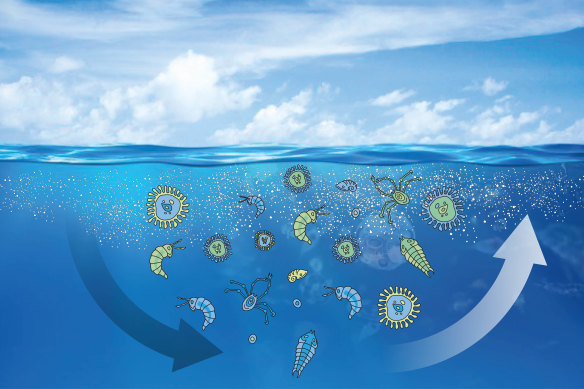
Iron filings dumped in the sea stimulate carbon-gobbling algal blooms, which take the carbon dioxide back down to the bottom of the ocean with them when they die.Credit: Jo Gay
Could dumping iron in the ocean really help?
Let's return to George and his iron swirling off the coast of Canada. The idea of trapping carbon in the sea was first proposed in the '90s by the late oceanographer John Martin, who suggested algae-spawning iron dust had helped usher in the last Ice Age. "Give me half a tanker of iron and I’ll give you an Ice Age," he is said to have once quipped at a lecture (in his best Dr Strangelove voice).
All plants absorb and store carbon and, over millennia, what carbon dioxide survives in them is compressed down through the weight of the Earth and the sea into what we now extract as fossil fuels. The deep ocean is like deep space, experts say: whatever reaches a certain depth underwater can’t get back to the surface inside at least a thousand years.
George claimed his experiment as a win - the resulting plankton bloom stretched over 10,000 square kilometres. But there were also reports of red tides rolling in – toxic crimson phytoplankton known to starve seawater of oxygen.Four years earlier, the UN had banned such large-scale ocean "fertilisation" amid warnings from scientists that it could accelerate sea acidification and damage ecosystems. After George’s experiment, and growing interest from other companies, Australia helped push through changes to make the ban binding under international maritime law, too.
Dr Graeme Pearman, former head of the CSIRO's atmospheric research arm, says the risks posed by ocean fertilisation are too high for the amount of carbon it could remove. He argues it would be safer, and cheaper, to invest in land-based methods such as scaling up tree planting and improving farming methods to keep carbon in the soil.
Professor David Karoly, a former lead author on the IPCC, agrees the method could threaten certain ecosystems. "But so will marine heat waves [due to climate change]," he says.
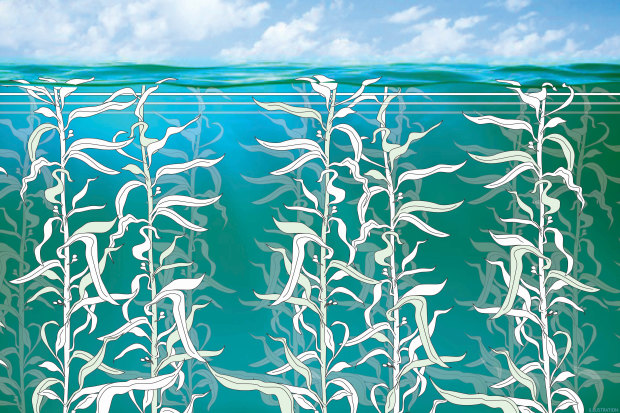
Seaweed: a hero the marine world?Credit: Jo Gay
Will seaweed farming help the planet?
Flannery points to another unlikely hero of the marine world. Seaweed can grow alongside fish without the toxic results of algae and already comes with a $6 billion farming industry behind it.
More than two-thirds of the Earth’s surface is ocean. If 9 per cent of that sea – an area roughly 4½ times the size of Australia – was converted into seaweed farms for carbon capture, Flannery expects they could draw down the same amount of carbon dioxide that the world emits in a year, roughly 55 gigatonnes. Most of the product would be cut and stored, either on the seafloor or in disused mines and oil wells. Some could even be turned into methane to generate electricity – or fed to cows to stop them producing their own.
The so-called "blue carbon solution" is particularly attractive, given that existing methods of capture, such as building carbon dioxide fans to strip it from the air, remain slow and expensive. Some companies are seeing results, including Climeworks in Switzerland, which sells harvested carbon dioxide as gas that can be turned into soda drink bubbles, plant fertiliser and biofuel. But the cost of removing one tonne of carbon dioxide still sits at $US100 ($150).
In June, Flannery is gathering world experts for a "seaweed symposium" in Paris examining the viability of a large-scale rollout and potential risks. "Within a decade, it could probably start taking out one gigatonne of carbon a year," Flannery says. "That's still not a lot. Imagine you're in that lab in Sydney poring over the very first solar panel. That's where we are with seaweed, at the very first glimmering of an idea. But I’m hopeful."
Sam Elsom at Australian seaweed carbon storage start-up Sea Forest, says private enterprise is often braver than governments, and now moving faster to save the planet.
"There will be a new economy built around solutions," he says. "It’s whether or not it happens fast enough."
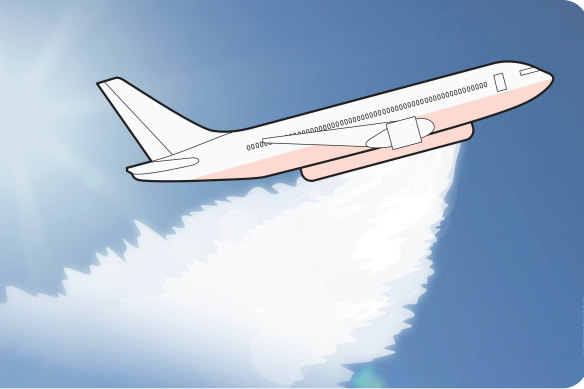
Scientists say technology to fly large payloads of sulphur into the stratosphere already exists or is within reach.Credit: Jo Gay
Could we try mimicking volcanos?
When Mount Pinatubo erupted in 1991, it shot 20 million tonnes of sulphur skyward. Over the following two years, the planet cooled by about half a degree. It's an aeons-old phenomenon – those particles volcanoes periodically spew into the air act as tiny mirrors reflecting light when they hit the stratosphere. But data from Pinatubo left scientists with the beginnings of a plan – could they recreate their own cooling "eruption" using high-speed jets?
At Harvard, Keith now expects the world could mask about half of its coming warming with the help of a few million tonnes of sulphur each year. A modified plane fleet could take off from the tropics, somewhere near the equator. They’d climb 20 kilometres into the sky – outstripping commercial aircraft – and during roughly 120,000 flights a year spray reflective particles directly into the stratosphere, dimming the sunlight hitting the Earth by 1 per cent. All for just a few billion dollars.
It’s the kind of scheme that could attract another businessman such as George, a "Band-Aid" to keep the climate liveable until the world’s energy transition catches up and carbon dioxide drops.
Because the stratosphere circulates air differently than down here in the troposphere, particles would hang overhead for about two years before falling. Researchers expect less would be needed than the amounts already spat out as air pollution at ground level, whichkills millions of people each year.
But the plan could also veer wildly off course.
It's within the reach of a single wealthy individual to set the thermostat for the entire planet.
Tim Flannery
"Those particles are already in the urban haze. We stopped using [many of] them because they're so dangerous to our health," Karoly says. "Sydney, Melbourne and Canberra have discovered [the problems] first-hand this year. It’s using one [pollutant] to offset another."
All that sulphur also eats into the ozone layer. And some scientists warn the dimming of sunlight could have untold consequences for plants and animals on the ground. Or the stratosphere itself could heat up and throw off natural circulation systems such as the jet stream and the Asian monsoon, driving more extreme weather.
"I can see one country invading another because they've stolen their rainfall and they can't grow crops," says Professor Will Steffen, another Australian IPCC author.
But Keith says that research suggests dispersal of aerosols near the equator would give fairly even coverage across the globe. And, if the climate models are to be trusted, no particular region would be significantly worse off in the weather department.
Lizzie Burns, managing director of Harvard's program, says researchers are now looking at other reflective particles that might pose less danger to both health and the ozone, from diamond dust to calcium carbonate or limestone. In the coming months, they hope to launch a stratospheric balloon to test a tiny amount of this chalky mineral up high.
Still, Karoly says suggestions the technology can be introduced gently and then tapered off seem far too idealistic – what if sulphur injections give the planet a habit it can’t kick or trigger rapid catastrophic warming if suddenly cut off?
"We need to know a lot more," Keith stresses. "But I think it's something some countries might well push onto the agenda within a decade or a little more."

More out of this world geo-engineering ideas include building giant mirrors or fleets of reflective satellites in space to block some of the sun's intensity.Credit: Jo Gay
Could we build a giant space shade?
Imagine a fleet of tiny, reflective satellites moving in unison across hundreds of millions of kilometres in space – and blocking out about 1 per cent of the sun's rays. Or clouds of moon dust shading the Earth.
Installing some kind of space shade or mirror on high could, in theory, limit global warming while avoiding both the health and geopolitical consequences of using particles in the lower atmosphere.
An object big enough to block out enough light would likely span at least 500,000 sq km.
Burns and Keith have just hosted some of the world's top minds in space engineering at Harvard to re-examine the idea now the price of space tech has fallen. But Burns admits that, for all its advantages, most of the ideas are still in the realms of science fiction. Keith says in the second half of the century such plans could gain traction. But Karoly doubts they will ever get off the ground based on sheer scale alone - an object big enough to block out enough light would likely span at least 500,000 square kilometres.
"It's like building a million international space stations, and getting them up, and none of them crashing," he says.
Still, he continues the thought experiment for argument's sake: "There's a lot of second-hand CDs no one wants any more and they're shiny ..."
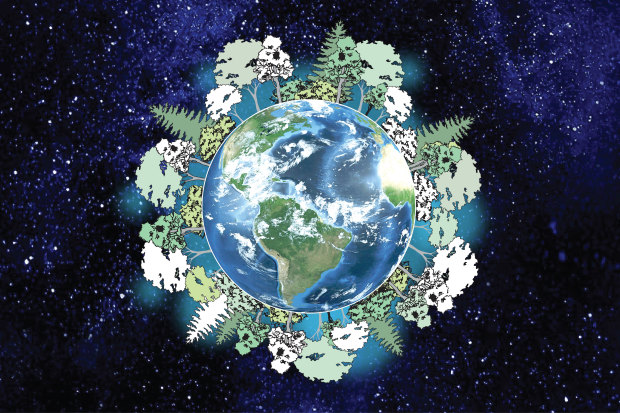
A reforestation solution would involve increasing the world's tree canopy by about 25 per cent.Credit: Jo Gay
Would tree planting actually work?
Technically, when Trump pledged this support for the One Trillion Trees initiative at the World Economic Forum, he already had a head start. In 2017 his repeated public denial of climate science inspired a tree planting campaign known as Trump Forest, which aimed to offset the amount of carbon released into the air due to the President’s energy policies. Three years on, Trump Forest has shut down but more than one million trees stand in his name.
So does planting trees really make up for belching out carbon emissions?
Trees are still considered among the best carbon capture technology in existence and, unsurprisingly, large-scale land clearing is to blame for a good chunk of emissions. They are also conveniently non-partisan, as one executive at the World Economic Forum pointed out: "Everyone’s pro-trees."
In 2019, the one trillion figure was put forward by researchers analysing how many trees could be planted without encroaching on urban or agricultural areas. Increasing the world's canopy by 25 per cent, they argued, could pull down about a quarter of its carbon. That has since been criticised by some as an overestimate, but Pearman and even NASA have defended reforestation as a promising option, noting that half of all emissions from car exhausts are absorbed by the ecosystem.
"With more CO2 in the air, trees are actually getting better at taking it out," Pearman says. "It's like fertiliser."
Planting trees is always a good idea but it won't get us out of this.
But experts say it is vitally important to restore biodiversity as well as just tree cover. As deforestation continues its march across the world at breakneck speed, species extinction is putting ecosystems and the wider climate system in jeopardy.
Karoly points to Australia's horror summer as a case for not relying too heavily on an all-in reforestation fix. "Trees burn and they release carbon, even if we don't count that towards our emissions," he says. "We also need land to grow food. We don't have the room."
Flannery calculates an area almost the size of the United States would have to be covered in trees to make a climate-saving dent in warming. "Planting trees is always a good idea but it won't get us out of this," he says. "And [the carbon] wouldn't be very securely stored."
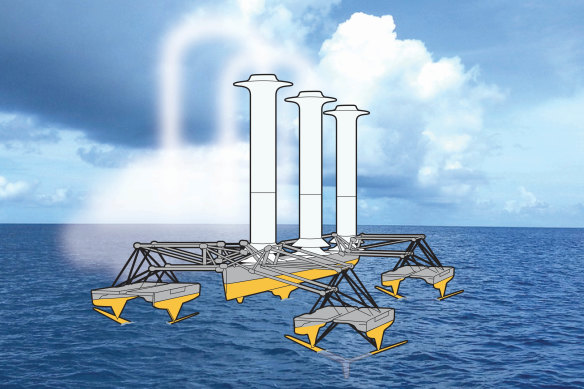
Marine "cloud brightening" involves seeding the sky with salt water pumped up from ships skimming the ocean, in order to reflect more light.Credit: Jo Gay
What other ideas are out there?
Then there's fake metal trees designed to suck out carbon for storage underground. Or barricades to block warm water from building up around the polar ice caps. It's even been suggested the Earth's axis could be pulled a fraction further away from the sun. Many ideas, including "brightening" clouds by pumping seawater into the sky from a fleet of self-steering ships, focus attention on saving the world's two polar ice caps from the big melt. Should the Earth lose their reflective cover, many experts say the climate system will unravel no matter how quickly emissions fall. Others, including Karoly, point to the benefits of white reflective paint on roofs and buildings worldwide.
But Pearman and Burns both caution against localised approaches. While shrinking geo-engineering in scale might seem safer and help cities cope in heat waves, pushing around hot air could also throw off the Earth's delicate climate system, including the jet stream.
So how likely is all this?
For geo-engineering to play a serious role in the decades to come, the team at Harvard says the drought in research funding has to break. Many of the ideas being considered were first imagined in the 1970s but a taboo has lingered over the field as efforts – "quite rightly" – focused on decarbonisation.
Still, some fear the mere mention of geo-engineering will distract from the clean energy shift. Or even set off world war.
"There are some real concerns there but we think it's more dangerous to do research in a black box," Burns says. "We want lots of people looking at this, looking for the risks. We know it can't solve climate change, it’s not a get-out-of-jail-free card. The question is: can it help us get through the worst of it?"
Karoly likens geo-engineering to an experimental treatment for a fever – it’s not a cure, it's a new disease to make you colder. It might balance things out but it could also make them a whole lot worse.
Proponents point out that the world has already been engaged in geo-engineering since the industrial revolution – when it began its experiment in spewing out huge amounts of carbon dioxide into the atmosphere.
Others reply, "And just look how that’s going."
Let us explain
If you'd like some expert background on an issue or a news event, drop us a line at explainers@smh.com.au or explainers@theage.com.au. Read more explainers here.